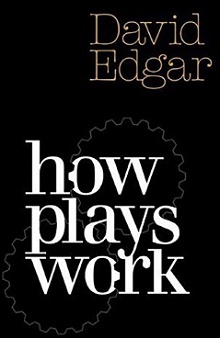| Width & Wisdom: Summer Theatre Book |
David Edgar |
| David Edgar- How Plays Work , Nick Hern Books , May 31, 2019 |
 Description is often a better educator than prescription. There is not a charity shop that does not offer a stack of “how-to” books on painting and illustration. As primers they all have something of interest to say. But the jump is still huge when it comes to picking up charcoal or pastel to make form or meaning. Description needs to be what Ryle and Geertz called thick and its source needs to be that of a master. David Edgar has been in theatre, as practitioner and commentator, for 48 years and is such a master. “How Plays Work”, nine years old and frequently reprinted, is not just a primer but a refreshing and stimulating read in in its own right.
Description is often a better educator than prescription. There is not a charity shop that does not offer a stack of “how-to” books on painting and illustration. As primers they all have something of interest to say. But the jump is still huge when it comes to picking up charcoal or pastel to make form or meaning. Description needs to be what Ryle and Geertz called thick and its source needs to be that of a master. David Edgar has been in theatre, as practitioner and commentator, for 48 years and is such a master. “How Plays Work”, nine years old and frequently reprinted, is not just a primer but a refreshing and stimulating read in in its own right.The pleasure is in the punch of style, the breadth of reference and the company of the author. If he is austere even slightly alarming in person, in print he is generous and far-seeing. John Godber even receives a commendation for his mastery of a particular strand of play. Edgar's approach is low on theory and high on example. His concern is theatre that has fused with audiences. He cites a philosopher, Mary Midgley, but only as a comment on the nature of evil. He brings in the makers of rules from Aristotle and Vauquelin to Syd Field. Anthony Minghella took pride in “The English Patient” being used as an example of how not to write a script. The Robert McKee prescriptive formula, says Edgar, damaged BBC drama. McKee, he says, now accepts open and closed endings, multiple protagonists, non-linear time The eight brisk chapters are thematic: audiences, actions, characters, genre, structure, scenes, devices, endings. The theatre he draws on for illustration vaults the centuries. How Etherege, Goldsmith and Sheridan did what they did is still valid for today. But classics are outnumbered by dramatists of now: Crimp, Eldridge, Griffiths, Keatley, Lavery, Nichols, Penhall, Ravenhill, Shaffer, Shinn, Roy Williams are just a sample. Edgar writes a lot of theatre but manifestly sees a lot too. Critics' voices are used sparingly in “How Plays Work.” But he cites David Lodge, Michelene Wandor, Jonathan Culler where they are needed. Eric Bentley says all that need be said on the making of dialogue. Properly made dialogue serves four purposes simultaneously. Edgar, like Bentley, is a writer of tautness, his longest chapter being “Devices.” In his terminology “devices are mechanisms for conveying dramatic meaning within scenes...the device goes to the very heart of what theatre is.” The examples of practice that follow take in Rattigan, Shakespeare, Churchill, Pinter, Friel. As for structure it is simply a grid of time and space, within which the dramatist reveals connections. On the topic of the internal architecture of connection he finds a source who declares that scenes “must be knotted together in such a way that the knots are easily noticed.” The prescriber is one B. Brecht. If theatre is liable to be tussled over that is sign of a lively culture. But it is not a lecture podium- it shows but does not teach. If it has a purpose it is to reveal the distemper of the times not to prescribe simple-hearted remedies for amelioration. Edgar's references roam over genre. John Grisham's sixth rule is “Give the protagonist a short time limit. Then shorten it.” “The Magic Mountain” is a novel of greatness. Jay Parini once asked Gore Vidal “do you think I can have characters talking for fourteen or fifteen pages about history and aesthetics and that sort of thing?” Vidal: “only if they are sitting in a railway carriage and there is a bomb under the seat.” Edgar calls it the ticking clock. He shows its application in “Romeo and Juliet”, “Skylight”, “Poor Bitos”, “Plenty”, even Coward and “Still Life.” The reading of “How Plays Work” is a return visit, prompted by 2018's recent seeing of plays of contrasting success. It lives up to its title in full. |
Reviewed by: Adam Somerset |
This review has been read 859 times There are 5 other reviews of productions with this title in our database:
|
